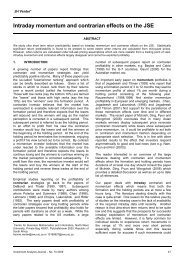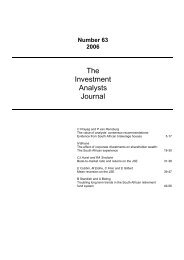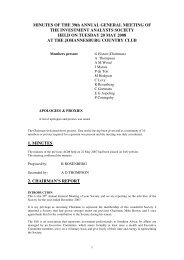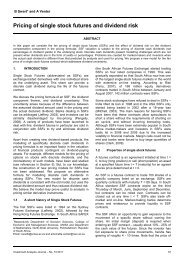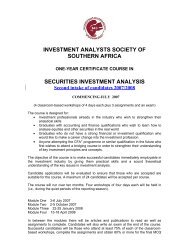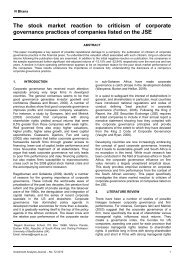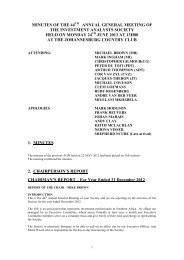Equity style timing - Investment Analysts Journal
Equity style timing - Investment Analysts Journal
Equity style timing - Investment Analysts Journal
You also want an ePaper? Increase the reach of your titles
YUMPU automatically turns print PDFs into web optimized ePapers that Google loves.
<strong>Equity</strong> <strong>style</strong> <strong>timing</strong><br />
the corresponding date twelve months later.<br />
Transaction costs, taxes, minimum block size<br />
requirements, impact cost and liquidity were not taken<br />
into account, as these factors were assumed to be<br />
relatively immaterial.<br />
5.4 Data integrity tests<br />
Both the BFA-NET and I-NET databases adjust data<br />
for share splits, consolidations and swaps. All the<br />
share price data was checked to ensure that this had<br />
been performed consistently. To confirm the accuracy<br />
of the data, an index comprising all the shares used<br />
each year was created. The returns from this index<br />
were plotted against the returns of the Industrial index.<br />
Since the population of (non-excluded) shares used in<br />
this study was the entire Industrial sector, whose index<br />
is the Industrial Index (J257), it was necessary to<br />
ensure that the share data closely tracked the index to<br />
confirm the reliability of the data.<br />
To ensure that all share splits and other actions were<br />
appropriately incorporated, a test was run to check<br />
whether any movement in share price in excess of<br />
40% month on month had occurred. A sample of such<br />
moves was examined and checked against corporate<br />
actions to ensure accuracy.<br />
If a share was de-listed during any twelve-month<br />
period, it was held in the portfolio until its last trading<br />
day, at which point the share was sold. For rights<br />
issues, a passive investment strategy was followed,<br />
therefore no rights were taken up; these were allowed<br />
to lapse.<br />
The book value was obtained from the BFA-NET<br />
database. It was calculated as ordinary capital plus<br />
distributable and non-distributable reserves, less the<br />
cost of control of subsidiaries and intangible assets.<br />
Where there were gaps in the data these were filled<br />
using FACtS Investors Guide.<br />
5.5 Portfolio return calculations<br />
For each portfolio, total monthly returns were<br />
calculated. Because it was not possible to identify the<br />
exact payment dates for dividends, it was assumed<br />
that they were received evenly during the year. Instead<br />
of using the actual dividend paid, Fama and French<br />
(1998) assumed that the dividend yield (defined as the<br />
trailing twelve-month dividend divided by the monthly<br />
closing price) would suffice in calculating total monthly<br />
returns. The annual dividend yield was accounted for<br />
as one-twelfth per month for the year. Compounding<br />
this monthly return reproduced the annual return. In<br />
using this method, they assumed that the capital gain<br />
component, measured monthly, accurately reproduced<br />
the volatility and covariance structure of total monthly<br />
returns.<br />
From each time series, cumulative monthly total<br />
returns were obtained in order to observe the total<br />
returns for the entire 20-year period.<br />
5.6 Prediction model<br />
An effective implementation of a <strong>style</strong> rotation strategy<br />
requires the development of a trading model to predict<br />
the appropriate switching events. Although not the<br />
main focus of this study, an attempt to construct an<br />
appropriate econometric model was made. In this<br />
context and following their rationale, the following<br />
macroeconomic variables identified by Kao and<br />
Shumaker (1999) and Levis and Liodakis (2000) were<br />
analysed:<br />
The (10 year vs 5 year) yield curve spread<br />
Corporate credit spread (AA vs BBB rated<br />
corporate bonds)<br />
Earnings yield gap (ALSI earning yield vs long<br />
bonds)<br />
The equity risk premium<br />
The inflation rate (historical CPI)<br />
The index of coincident economic indicators<br />
The rate of change of M3 money supply<br />
The return on the all share index<br />
The index of leading economic indicators<br />
A regression equation was constructed using the<br />
monthly return spread between value and growth<br />
portfolios as the dependent variable. To construct the<br />
model data from December 1986 to December 1993<br />
was used, so that the remaining data could be used to<br />
perform an out-of-sample test of the regression model.<br />
6. RESULTS<br />
Proposition 1: The market capitalisation effect<br />
occurs independently of the value effect.<br />
To test this proposition, the cumulative monthly returns<br />
obtained from the high price to book ratio (growth)<br />
portfolio were plotted together with those obtained<br />
from the low price to book ratio (value) portfolios. To<br />
ensure that the influence of size did not introduce bias<br />
into the result, this was conducted for both the large<br />
capitalisation and small capitalisation stocks<br />
independently.<br />
18 <strong>Investment</strong> <strong>Analysts</strong> <strong>Journal</strong> – No. 65 2007




